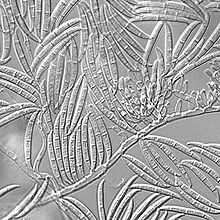A mycotoxin is a toxic secondary metabolite produced by fungi and is capable of causing disease and death in both humans and other animals. The term 'mycotoxin' is usually reserved for the toxic chemical products produced by fungi that readily colonize crops.

Fusarium is a large genus of filamentous fungi, part of a group often referred to as hyphomycetes, widely distributed in soil and associated with plants. Most species are harmless saprobes, and are relatively abundant members of the soil microbial community. Some species produce mycotoxins in cereal crops that can affect human and animal health if they enter the food chain. The main toxins produced by these Fusarium species are fumonisins and trichothecenes. Despite most species apparently being harmless, some Fusarium species and subspecific groups are among the most important fungal pathogens of plants and animals.

Khorasan wheat or Oriental wheat is a tetraploid wheat species. The grain is twice the size of modern-day wheat, and has a rich, nutty flavor.

Fusarium culmorum is a fungal plant pathogen and the causal agent of seedling blight, foot rot, ear blight, stalk rot, common root rot and other diseases of cereals, grasses, and a wide variety of monocots and dicots. In coastal dunegrass, F. culmorum is a nonpathogenic symbiont conferring both salt and drought tolerance to the plant.
Glomerella graminicola is an economically important crop parasite affecting both wheat and maize where it causes the plant disease Anthracnose Leaf Blight.
Alternaria triticina is a fungal plant pathogen that causes leaf blight on wheat. A. triticina is responsible for the largest leaf blight issue in wheat and also causes disease in other major cereal grain crops. It was first identified in India in 1962 and still causes significant yield loss to wheat crops on the Indian subcontinent. The disease is caused by a fungal pathogen and causes necrotic leaf lesions and in severe cases shriveling of the leaves.

Pyrenophora tritici-repentis (teleomorph) and Drechslera tritici-repentis (anamorph) is a necrotrophic plant pathogen of fungal origin, phylum Ascomycota. The pathogen causes a disease originally named yellow spot but now commonly called tan spot, yellow leaf spot, yellow leaf blotch or helminthosporiosis. At least eight races of the pathogen are known to occur based on their virulence on a wheat differential set.

Gibberella zeae, also known by the name of its anamorph Fusarium graminearum, is a fungal plant pathogen which causes fusarium head blight (FHB), a devastating disease on wheat and barley. The pathogen is responsible for billions of dollars in economic losses worldwide each year. Infection causes shifts in the amino acid composition of wheat, resulting in shriveled kernels and contaminating the remaining grain with mycotoxins, mainly deoxynivalenol (DON), which inhibits protein biosynthesis; and zearalenone, an estrogenic mycotoxin. These toxins cause vomiting, liver damage, and reproductive defects in livestock, and are harmful to humans through contaminated food. Despite great efforts to find resistance genes against F. graminearum, no completely resistant variety is currently available. Research on the biology of F. graminearum is directed towards gaining insight into more details about the infection process and reveal weak spots in the life cycle of this pathogen to develop fungicides that can protect wheat from scab infection.
Crown rot of wheat is caused by the fungal pathogen Fusarium pseudograminearum. F. pseudograminearum is a member of the fungal phylum Ascomycota and is also known as Gibberella coronicola (teleomorph). It is a monoecious fungus, meaning it does not require another host other than wheat to complete its life cycle. Although F. pseudograminearum can produce both anamorphic and teleomorphic states, the teleomorph is usually not present for crown rot of wheat. This Fusarium species has, until recently, been considered to be the same as the species known as Fusarium graminearum due to many similar characteristics. One of the only differences between the two species is that F. pseudograminearum lacks its sexual stage on the wheat host.
Fusarium incarnatum is a fungal pathogen in the genus Fusarium, family Nectriaceae. It is usually associated with over 40 phylogenetic species in the natural environment to form the Fusarium incarnatum-equiseti species complex(FIESC). This complex is widespread across the globe in subtropical and temperate regions, resulting in many reported cases of crop diseases. It produces various mycotoxins including trichothecenes zearalenone, causing both plant and animal diseases.
Fusarium sporotrichioides is a fungal plant pathogen, one of various Fusarium species responsible for damaging crops, in particular causing a condition known as Fusarium head blight in wheat, consequently being of notable agricultural and economic importance. The species is ecologically widespread, being found across tropical and temperate regions, and is a significant producer of mycotoxins, particularly trichothecenes. Although mainly infecting crops, F. sporotrichioides-derived mycotoxins can have repercussions for human health in the case of the ingestion of infected cereals. One such example includes the outbreak of alimentary toxic aleukia (ATA) in Russia, of which F. sporotrichioides-infected crop was suspected to be the cause. Although current studies on F. sporotrichioides are somewhat limited in comparison to other species in the genus, Fusarium sporotrichioides has found several applications as a model system for experimentation in molecular biology.
Fusarium equiseti is a fungal species and plant pathogen on a varied range of crops.
Fusarium tricinctum is a fungal and plant pathogen of various plant diseases worldwide, especially in temperate regions. It is found on many crops in the world including malt barley, and cereals.
Fusarium crookwellense is a species of fungus in the family Nectriaceae. It is known as a plant pathogen that infects agricultural crops.

Vomitoxin, also known as deoxynivalenol (DON), is a type B trichothecene, an epoxy-sesquiterpenoid. This mycotoxin occurs predominantly in grains such as wheat, barley, oats, rye, and corn, and less often in rice, sorghum, and triticale. The occurrence of deoxynivalenol is associated primarily with Fusarium graminearum and F. culmorum, both of which are important plant pathogens which cause fusarium head blight in wheat and gibberella or fusarium ear blight in corn. The incidence of fusarium head blight is strongly associated with moisture at the time of flowering (anthesis), and the timing of rainfall, rather than the amount, is the most critical factor. However, increased amount of moisture towards harvest time has been associated with lower amount of vomitoxin in wheat grain due to leaching of toxins. Furthermore, deoxynivalenol contents are significantly affected by the susceptibility of cultivars towards Fusarium species, previous crop, tillage practices, and fungicide use. It occurs abundantly in grains in Norway due to heavy rainfall.
Mycoestrogens are xenoestrogens produced by fungi. They are sometimes referred to as mycotoxins. Among important mycoestrogens are zearalenone, zearalenol and zearalanol. Although all of these can be produced by various Fusarium species, zearalenol and zearalanol may also be produced endogenously in ruminants that have ingested zearalenone. Alpha-zearalanol is also produced semisynthetically, for veterinary use; such use is prohibited in the European Union.

Epoxiconazole is a fungicide active ingredient from the class of azoles developed to protect crops. In particular, the substance inhibits the metabolism of fungi cells infesting useful plants, and thereby prevents the growth of the mycelia. Epoxiconazole also limits the production of conidia (mitospores). Epoxiconazole was introduced to the market by BASF SE in 1993 and can be found in many products and product mixtures targeting a large number of pathogens in various crops. Crops are, for example, cereals, soybeans, banana, rice, coffee, turnips, and red as well as sugar beets.
Many species of fungi produce secondary metabolites called mycotoxins. These toxins can be very detrimental to both humans and animals. The side-effects of ingesting these toxic substances are called mycotoxicosis, which can be a variety of medical conditions. The most common fungi that produce mycotoxins include Fusarium, Aspergillus, and Penicillium.

Fusarins are a class of mycotoxins produced mainly by fungi of the genus Fusarium, which can infect agriculturally important crops such as wheat, barley, oats, rye, and corn. Chemically, they are polyketides that are also derived from amino acids.

Stenocarpella maydis (Berk.) Sutton is a plant pathogenic fungus and causal organism of diplodia ear and stalk rot. Corn and canes are the only known hosts to date. No teleomorph of the fungus is known.









